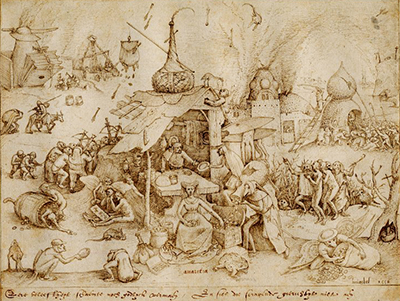Avarice outlines a world of chaos as Bruegel's creates a drawing which will remind many of the work of Hieronymus Bosch.
Activity can be found in each and every corner of this piece, delivering a style that contrasts markedly with the main protagonists of this era, the members of the Italian Renaissance. They would rarely make use of such disorder in work unless is was dictated by a specific biblical tale, such as The Last Judgement by Michelangelo. Bruegel was naturally drawn to this style of composition, particularly in the earlier years of his career.
There is a somewhat fantastical style to some of the items in this scene, such as the large lamp-shaped object which sits on top of the shack in the middle of the drawing. Figures are strewn across the scene, some interacting with objects scattered around, whilst others are involved in severe violence. Whatever the artist's intention, there is clearly not a positive atmosphere delivered in this piece.
The artist chose to leave a small note at the bottom of the artwork which can be read and translated to give a better understanding of both the items in the drawing but also the specific purpose of it. Was it a study drawing for others to learn from, or perhaps a single item purely for its own worth. Was it part of a series, or perhaps a design for a later etching? These many questions are hard to answer for something produced so long ago, even though Bruegel's career has been researched in such high detail.




